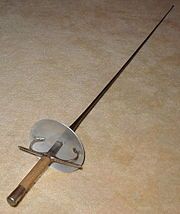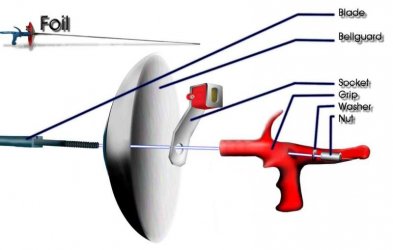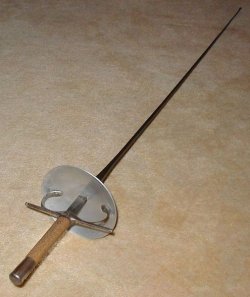Foil (fencing)
From Wikipedia, the free encyclopedia
A foil is a type of weapon used in fencing. It is the most common weapon in terms of usage in competition, and is usually the choice for elementary classes for Fencing in general.
Contents
Foils are designed for thrusting, and score a point by depressing a button on the end of the shaft to complete an electric circuit. The blade is very thin, with a blunted (or foiled) tip. Modern competitive fencers often use a technique known as a flick, which uses the foil's flexibility to bend around the blade of an opponent (often in response to an attempted parry) and plant a hit upon the back.
Foil blades are flexible enough to bend upon striking an opponent, in order to prevent injuries. There are three main types of foil grips: the French style, with a grip (handle or hilt) designed to facilitate greater finesse, the Italian style, which is designed more for control and power, and the orthopedic, or pistol-grip, which takes the need for a firm hold on the weapon even further. Critics of the pistol-grip, (who are almost invariably adherents of the classical philosophy), claim that this leads to a "deathgrip" on the foil that sacrifices speed and maneuverability for strength and stability (viewed as inferior by such critics), thus inhibiting true mastery. Still, the pistol grip remains the most popular, and it is almost invariably the grip of preference for the contemporary foil fencer.
History


An Italian-grip foil. While still in use with many classical fencers the Italian grip has been largely abandoned by most competitive fencers.
The modern foil is descended from the training weapon for the small-sword, a lighter version of the rapier that was the common sidearm of 18th century gentleman. (Rapier and even longsword foils are also known to have been used, but they were very different in terms of weight and use.)
The target area for modern foil is said to come from a time when fencing was practised with limited safety equipment. Another factor in the target area is that foil rules are derived from a period when dueling to the death was the norm. Hence, the favored target area is the torso, where the vital organs are.
Modern Foil
In modern sport fencing, the foil is used as a thrusting weapon only. Any contact with the side of the blade (a slap) is discounted. Modern foils average 35 inches or 89cm in length, and have standardized, tapered, quandrangular blades which are designed to present a blunt (and therefore non-lethal) tip should it snap. To score a touch one must touch an opponent with the tip of the foil with a force of at least 4.90 newtons (500 grams-force).
Foil is governed by right of way rules. As such, points are not necessarily awarded to the first fencer to hit, but to the fencer who hits with priority. Priority is established when one fencer starts an attack. After this, the defender can gain priority by making the attack fail (e.g. by making a parry) then initiating a counter attack or riposte. The initial attacker regains priority if the defender's riposte fails. The priority continues to exchange between the fencers until a hit is scored.
As with any fencing weapon, protective equipment must be worn when fencing with foils; this includes a jacket, glove, mask, and knickers (known as breeches in the UK). In electric fencing, the foil's tip must be depressed while in contact with the opponent's lamé (wire-mesh jacket which covers valid target area) to score a touch.
Foil fencers developed a new technique called a flick, in the 1980s, in response to the new FIE timings. This unconventional tactic has been the subject of much controversy, as classical fencers believe it is not a traditional strategy, but modern fencers defend it as a valid action.
==================
Text is available under the terms of the GNU Free Documentation License.
From Wikipedia, the free encyclopedia
A foil is a type of weapon used in fencing. It is the most common weapon in terms of usage in competition, and is usually the choice for elementary classes for Fencing in general.
Contents
- 1 Components
- 2 History
- 2.1 Modern Foil
- 3 References
- 4 See also
Foils are designed for thrusting, and score a point by depressing a button on the end of the shaft to complete an electric circuit. The blade is very thin, with a blunted (or foiled) tip. Modern competitive fencers often use a technique known as a flick, which uses the foil's flexibility to bend around the blade of an opponent (often in response to an attempted parry) and plant a hit upon the back.
Foil blades are flexible enough to bend upon striking an opponent, in order to prevent injuries. There are three main types of foil grips: the French style, with a grip (handle or hilt) designed to facilitate greater finesse, the Italian style, which is designed more for control and power, and the orthopedic, or pistol-grip, which takes the need for a firm hold on the weapon even further. Critics of the pistol-grip, (who are almost invariably adherents of the classical philosophy), claim that this leads to a "deathgrip" on the foil that sacrifices speed and maneuverability for strength and stability (viewed as inferior by such critics), thus inhibiting true mastery. Still, the pistol grip remains the most popular, and it is almost invariably the grip of preference for the contemporary foil fencer.
History


An Italian-grip foil. While still in use with many classical fencers the Italian grip has been largely abandoned by most competitive fencers.
The modern foil is descended from the training weapon for the small-sword, a lighter version of the rapier that was the common sidearm of 18th century gentleman. (Rapier and even longsword foils are also known to have been used, but they were very different in terms of weight and use.)
The target area for modern foil is said to come from a time when fencing was practised with limited safety equipment. Another factor in the target area is that foil rules are derived from a period when dueling to the death was the norm. Hence, the favored target area is the torso, where the vital organs are.
Modern Foil
In modern sport fencing, the foil is used as a thrusting weapon only. Any contact with the side of the blade (a slap) is discounted. Modern foils average 35 inches or 89cm in length, and have standardized, tapered, quandrangular blades which are designed to present a blunt (and therefore non-lethal) tip should it snap. To score a touch one must touch an opponent with the tip of the foil with a force of at least 4.90 newtons (500 grams-force).
Foil is governed by right of way rules. As such, points are not necessarily awarded to the first fencer to hit, but to the fencer who hits with priority. Priority is established when one fencer starts an attack. After this, the defender can gain priority by making the attack fail (e.g. by making a parry) then initiating a counter attack or riposte. The initial attacker regains priority if the defender's riposte fails. The priority continues to exchange between the fencers until a hit is scored.
As with any fencing weapon, protective equipment must be worn when fencing with foils; this includes a jacket, glove, mask, and knickers (known as breeches in the UK). In electric fencing, the foil's tip must be depressed while in contact with the opponent's lamé (wire-mesh jacket which covers valid target area) to score a touch.
Foil fencers developed a new technique called a flick, in the 1980s, in response to the new FIE timings. This unconventional tactic has been the subject of much controversy, as classical fencers believe it is not a traditional strategy, but modern fencers defend it as a valid action.
==================
Text is available under the terms of the GNU Free Documentation License.


